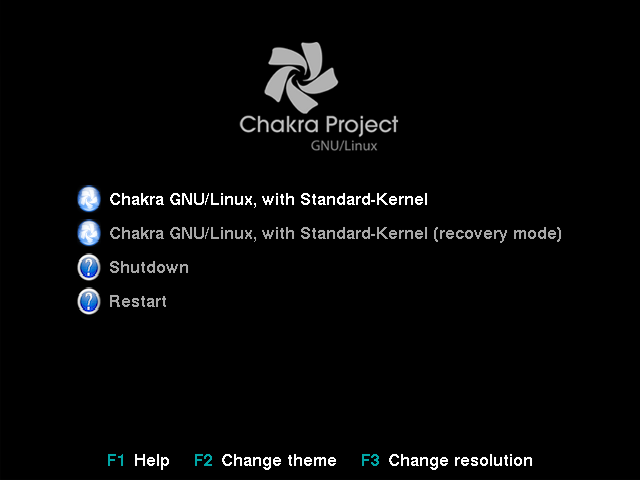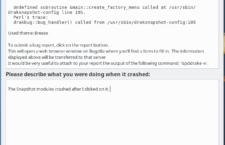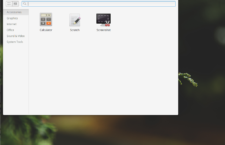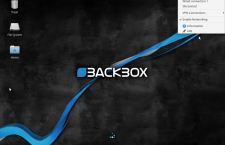Chakra Edn 2011.12 is the third and final edition of the Chakra Edn line of Chakra, a desktop GNU/Linux distribution based on Arch Linux. The first two editions were Chakra Edn 2011.09 and Chakra Edn 2011.11 (see Chakra Edn 2011.11 review).
I always like to start my reviews by providing information about the installer and installation process of the distribution being reviewed, but since there were no changes or new features in Tribe, Chakra’s installation program, there is no point in rehashing information that is already available in Chakra Edn 2011.11 review. A few screen shots should be enough.
If you are new to Chakra, you may want to read that review and Chakra GNU/Linux review for a detailed description of the installer and installation process. Also, all articles (reviews and tutorials) about Chakra that has been published on this website are on the distribution’s category page at http://www.linuxbsdos.com/category/chakra.
For users already familiar with Chakra, here are a few screen shots of the installer from the latest release. The screen shot below shows the list of available Bundles. Bundles are how Chakra makes non-native KDE applications available for installation.

And this is of the boot loader installation step. Unlike other Linux distributions, Chakra uses BURG, instead of GRUB, as the default boot loader. BURG is based on GRUB, the GRand Unified Bootloader.

By using BURG, Chakra gives you this beautiful (compared to that of GRUB) boot loader screen.

A beautiful screen shot of installation in progress.

Ok, with the old stuff out of the way, here is a list of the new stuff in Chakra Edn 2011.12:
- KDE 4.7.4
- (Linux) Kernel 3.1.4 (2.6.35.14 optional)
- Updated sound-stack
- Tomoyo-tools 2.5 added to a default install, for more security options
- Wqy-microhei became the new default font for Chinese/Japanese/Korean
- QtWebkit 2.2
- Updated initscripts with the option to test systemd
- Updated mesa-stack
- Included more popular GTK-apps as bundles
The release announcement stated that more popular GTK applications were included as bundles, but I counted 28 in this release, while the previous release (Chakra Edn 2011.11) shipped with 29 bundles installable from Bundle Manager. Perhaps a few, less popular ones were replaced with more popular applications. The complete list of bundles that shipped with Chakra Edn 2011.12 are shown in the next two images.

And the list continues. Note that though QupZilla is listed as a ready-to-install bundle, it is installed by default, so I do not see why it is listed as such in the Bundle Manager. There must be something special about QupZilla because it is the only bundle that is also installable from AppSet-Qt, the main graphical package manager. Other bundles that I checked can only be managed from Bundle Manager. And considering that QupZilla is a Qt application, I am not so sure that it should have been listed as a bundle in the first place.

While the inclusion of more popular GTK applications is a good thing, for me, the most important new feature is Tomoyo-tools, a host-based application firewall, which is one of 3 available in Linux. An application firewall complements an operating system’s stateful packet filtering firewall. Fedora uses SELinux, while Ubuntu and distributions derived from it use AppArmor. Chakra is the first Linux distribution reviewed on this website this year to include Tomoyo in its stable edition. Note, though, that it is not activated by default. Tomoyo will also be the default application firewall in Mageia 2, but that will not be released until May 2012.
Making Tomoyo available is a nice addition to Chakra, but several shortcomings of the previous release which I drew attention to in Chakra Edn 2011.11 review, were not addressed in this latest edition. For example, the firewall is not activated out of the box. Also, CUPS, the printing daemon, is not activated, so setting up any printer on the system will always be a manual process. Always, until the developers set it up to auto-configure printers like we have in Pardus, Linux Mint, Ubuntu and other distributions.
Another minor issue which I drew attention to in that review of the previous edition, is that the home directory is missing the usual cast of folders that you see in other distributions. So the first task that you have to address in a new installation of Chakra Edn 2011.12, is to create the folders yourself. The screen shot below shows the default home folder of a user account as viewed from Dolphin, the file manager.
































I disagree with the preset folders. Not including them is a feature, not a bad thing. I don’t want someone else trying to tell me what folders to use, I have my own naming convention. I delete such folders in any Linux distribution I install and make my own.
As for the takeoff menu, absolutely not. It looks horrible and takes up an ENTIRE screen of real estate, and it takes longer to get to an application than Kickoff does. This is your personal preference, not something that should be done by default. I can tell you from experience that if this was default in any distribution, it would result in user outcry.
I’m a chakra user and i’m happy they don’t have a preset of folders in home. It was always the first thing i removed to make my own folders,just like Ista above.
Cups i think i something most will need but isn’t hard to do if you follow the wiki.
I hope the stay close to stock kde, mostly you customize it to your own needs and that is for every user different. I rather put things in i need than remove things i don’t need.
And i want to compliment the dev people of chakra they are always ready to answer question in there forum/irc and stay always friendly. That was something i missed on a few other distro’s and one of the main reasons i stick to chakra.
I’m surprised you didn’t include full-disk encryption in your list of suggested features for the next edition of Chakra. 🙂
Your reviews and especially your tutorials are excellent, and really helped me in my move to Linux earlier this year. Two things I’d like to see you cover:
-How to implement full-disk encryption on a dual-boot laptop. (I keep my data is on a separate NTFS partition so I can access it from both OSs — I still need Win7 for some of my work.)
-Your take on the Enlightenment/E17 desktop environment. Bodhi Linux seems to be the most popular distro built around it.
Thanks, Finid!
just checked out chakra and was impressed with the live cd. im new to the arch branch so was very interesting. like the fact that xbmc is built into the packages as i have been trying to find a distro that will run this flawlessly.
I don’t like the fact that it’s impossible to install the boot loader on the boot partition itself (you can only install it onto the MBR) …
this might help:
http://chakra-project.org/bbs/viewtopic.php?pid=43603
I don’t think the lack of pre-populated home directories is a drawback at all. Unlike the distro reviewer, the typical user wants to migrate existing directories for other computers / partitions to their new one. One of the first things I do with any new Linux install is delete any directories under /home/myname and copy over my existing home directory structure. From my perspective leaving the home directory empty is a feature.
I think you mean “Chakra Linux.” Nobody calls it GNU/Linux except Richard Stallman and other people who want to give the FSF an inappropriately large amount of the credit for developing the Linux operating system.
Why must you expose your ignorance about the history of Linux or GNU/Linux in public?
GNU software and the Linux kernel are like the left and right hands on the same body.
Study some more, wise guy.
Thanks for taking the time to do this review. Explanation for the qupzilla as bundle too. All bundled browser include the flashplugin (which ofc cannot be included in a GTK2 free ISO), since many user like to keep their system GTK2 free, it was requested that at least one Qt browser was available with flash bundled-in too.
Chakra –as noted in a comment of a previous review, and explained in the welcome-plasmoid– never intended to make all the decisions for the user. I’ll quote the goal of Chakra:
“The Chakra Project is dedicated to providing a pure KDE/Qt desktop operating system that is simple and transparent. The LiveCD is an important tool and key to the user’s first impression, while the half-rolling release model ensures cutting edge features with solid system stability and long life. Simplicity is great for users new to Linux, but simple doesn’t mean that you won’t have to learn anything. Getting the most from Chakra requires a certain level of competency and is more focused toward KISS-minded users who aren’t afraid to get their hands dirty. However, if you are willing to learn and put in a little effort, Chakra is an excellent distribution to start with. It requires a minimum of distro-specific knowledge, and it’s bare-bones install is rock-solid and easy to manipulate. There is also a wonderful Beginnerâs Guide available in the wiki, helping to guide you through the process of learning to use Chakra, KDE, and thus Linux, from the beginning.”
This applies to any settings, folders, firewall, security, the tools are available, it is the users choice how to use them.
maybe qupzilla is in the bundle cause it’s qupzilla+flash?
Why would they need to bundle qupzilla+flash when QupZilla is pre-installed and Adobe Flash is installable from AppSet-Qt?
Because a bundled browser+flash is self contained and to use flash in a browser installed normaly you would have to install gtk2 as a dependency to flash wich beats the whole point of a gtk+ free distro
I must say, Chakra Linux is really getting my pumped up. It seems a realy polished, well thought, well implemented OS. IMHO, i think there are some shortcomings, besisdes the ones mentioned on this very detailed review,like the lack of a dedicated email and chat applications. I recommend Kontact an telepathy, because they are kde native. The security features should be all on by default, tomoyo included… even if there is a tutorial on their wiki, using the terminal isn’t the most intuitive way to configure the os, for some users. I’m really glad to see this OS with such great potential continuing to release new native applications and bundles with each release to pleaase everyone taste… it is really the way to go. On a final note, would like to, if possible, contribute to this project… i don’t have much experience with things like this, but seeing this OS growing so fast (congratulations on your 6th place of most rapidly growing projects!) and with so much potential, i really feel like contributing, even a little, to make this a great distro. Very well done! best pof luck!